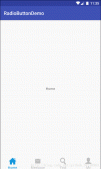android本身已经提供了progressdialog进度等待框,使用该dialog,我们可以为用户提供更好的体验:在网络请求时,弹出此框等待网络数据。 不过,既然是为了提高用户体验,我们肯定希望该dialog能更加炫酷,让用户看着更舒服。那如何做呢,当然是我们自己定义一个progressdialog了。
可以先看下,接下来将实现的dialog效果图:

步骤1:要定义布局文件,该布局文件即是dialog的布局了
|
1
2
3
4
5
6
7
8
9
10
11
12
13
14
15
16
17
18
19
20
21
22
23
24
25
26
27
|
<?xml version="1.0" encoding="utf-8"?> <linearlayout xmlns:android="http://schemas.android.com/apk/res/android" android:id="@+id/dialog_view" android:layout_width="fill_parent" android:layout_height="fill_parent" android:background="@drawable/dialog_load_bg" android:gravity="center" android:minheight="100dp" android:minwidth="190dp" android:orientation="vertical" android:padding="10dp" > <imageview android:id="@+id/img" android:layout_width="wrap_content" android:layout_height="wrap_content" android:src="@drawable/publicloading" /> <textview android:id="@+id/tiptextview" android:layout_width="wrap_content" android:layout_height="wrap_content" android:layout_marginleft="10dp" android:textcolor="#acacac" android:textsize="15sp" /> </linearlayout> |
在布局文件中,我们只定义了两个组件,一个imageview,用于显示旋转图,一个textview,用于显示消息文本
步骤2:定义动画,使得弹出框上的图片可以不停的旋转。
|
1
2
3
4
5
6
7
8
9
10
11
12
13
|
<?xml version="1.0" encoding="utf-8"?> <set android:shareinterpolator="false" xmlns:android="http://schemas.android.com/apk/res/android"> <rotate android:interpolator="@android:anim/linear_interpolator" android:pivotx="50%" android:pivoty="50%" android:fromdegrees="0" android:todegrees="+360" android:duration="1500" android:startoffset="-1" android:repeatmode="restart" android:repeatcount="-1"/> </set> |
步骤3:实现自定义的dialog逻辑
|
1
2
3
4
5
6
7
8
9
10
11
12
13
14
15
16
17
18
19
20
21
22
23
24
25
26
27
28
29
30
31
32
33
34
35
36
37
38
39
40
41
42
43
44
45
46
|
/** * 公用的弹出框 * * @author lining */public class loadingdialog { /** * 得到自定义的progressdialog * * @param context * @param msg * @return */ public static dialog createloadingdialog(context context, string msg) { // 首先得到整个view view view = layoutinflater.from(context).inflate( r.layout.loading_dialog_view, null); // 获取整个布局 linearlayout layout = (linearlayout) view .findviewbyid(r.id.dialog_view); // 页面中的img imageview img = (imageview) view.findviewbyid(r.id.img); // 页面中显示文本 textview tiptext = (textview) view.findviewbyid(r.id.tiptextview); // 加载动画,动画用户使img图片不停的旋转 animation animation = animationutils.loadanimation(context, r.anim.dialog_load_animation); // 显示动画 img.startanimation(animation); // 显示文本 tiptext.settext(msg); // 创建自定义样式的dialog dialog loadingdialog = new dialog(context, r.style.loading_dialog); // 设置返回键无效 loadingdialog.setcancelable(false); loadingdialog.setcontentview(layout, new linearlayout.layoutparams( linearlayout.layoutparams.match_parent, linearlayout.layoutparams.match_parent)); return loadingdialog; } } |
代码注释已经很详细了,有一处需要注意的,就是在创建dialog实例时,需要传递一个theme,该theme是dialog的风格:
|
1
2
3
4
5
6
7
8
|
<!-- 自定义loading dialog --> ;style name="loading_dialog" parent="android:style/theme.dialog"> <item name="android:windowframe">@null</item> <item name="android:windownotitle">true</item> <item name="android:windowbackground">@drawable/dialog_load_bg</item> <item name="android:windowisfloating">true</item> <item name="android:windowcontentoverlay">@null</item> ;/style> |
步骤4:使用自定义的progressdialog
接下来,我们可以直接使用已经定义好的dialog了,很简单,只需要将dialog显示和关闭即可,建议将讲方法封装起来,放在
|
1
2
3
4
5
6
7
8
9
10
11
12
13
14
15
16
17
18
19
20
|
baseactivity(基类)中,方便随时调用。/** * 显示dialog */private void showdialog() { if (dialog == null) { dialog = loadingdialog.createloadingdialog(this, "正在加载中..."); dialog.show(); } } /** * 关闭dialog */private void closedialog() { if (dialog != null) { dialog.dismiss(); dialog = null; } } |
通过上面步骤,我们即完成了自定义的progressdialog,当然,具体在项目中需要什么样的效果,可以调整。
















